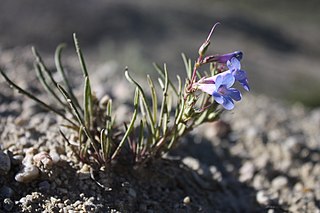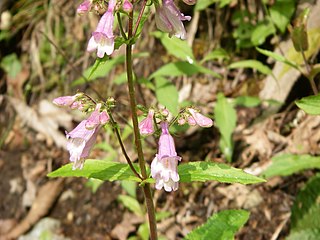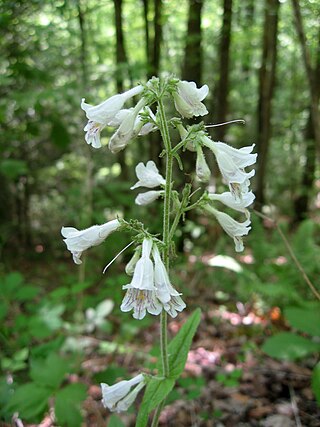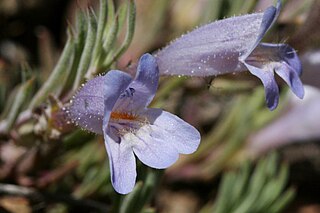
Penstemon barbatus, known by the common names golden-beard penstemon, and beardlip penstemon, is a flowering plant native to the western United States.

Penstemon barnebyi is a species of penstemon known by the common names White River Valley beardtongue and Barneby's beardtongue. It is native to the mountain and basin territory of central western Nevada, where it grows in sagebrush and woodland; there is also one occurrence just over the California border.

Penstemon calcareus is a species of penstemon known by the common name limestone penstemon. It is native to California, where it is known from the deserts of central San Bernardino County, as well as the Death Valley area, where its distribution extends just over the border into Nevada. It grows in scrub and woodland, often on limestone substrates.

Penstemon grandiflorus, known by the common names shell-leaved penstemon, shell-leaf beardtongue, or large-flowered penstemon, is a tall and showy plant in the Penstemon genus from the plains of North America. Due to its large flowers it has found a place in gardens, particularly ones aimed at low water usage like xeriscape gardens.

Penstemon penlandii is a rare species of flowering plant in the plantain family known by the common names Penland penstemon and Penland's beardtongue. It is endemic to Colorado in the United States, where it is known only from a strip of land about five miles long in central Grand County. There are two occurrences totalling about 8600 individuals. This is a federally listed endangered species of the United States.

Penstemon canescens is a species of penstemon in the family Plantaginaceae. P. canescens is known by the common names gray beardtongue or Appalachian beardtongue. It is native to woodlands, forest edges, and roadsides of the southeastern United States and flowers May through July. It is a perennial herb producing stems reaching 80 centimeters in maximum height.

Penstemon angustifolius is a perennial semi-evergreen forb belonging to the plantain family. This species is 1 out of roughly 273 species of Penstemon. This species is also known as broadbeard beardtongue. This forb is native to central United States and can be noticed by its brightly and highly variable colored flowers.

Penstemon brevisepalus, commonly known as short-sepaled beardtongue, is an herbaceous plant in the plantain family. It is a perennial that produces pale lavender flowers in late spring.

Penstemon tenuis is a species of flowering plant in the plantain family known by the common name sharpsepal beardtongue. It is endemic to Texas, Louisiana, Mississippi, and Arkansas in the United States where it is found in open, damp areas in alluvial soil. It typically flowers from early April into early June.

Penstemon australis is a perennial plant native to the southeastern United States, with the common name Eustis Lake penstemon.

Penstemon whippleanus, commonly known as dusky penstemon, dusky beardtongue, Whipple's penstemon, or Whipple's beardtongue, is a summer blooming perennial flower in the large Penstemon genus. It is a widespread plant within the hemiboreal forests of the Rocky Mountains in North America. It is noted for the large deep purple-red flowers and a preference for high mountain elevations.

Penstemon virens, commonly known as blue mist penstemon, Front Range penstemon, or Green beardtongue, is a common Penstemon in the Front Range foothills in Colorado and Wyoming. The dainty flowers are an ornament to many rocky or sandy area within its range. It is confusingly similar to Penstemon humilis and Penstemon albertinus though the ranges of these plants do not overlap in the wild. The origin of calling it the "blue mist penstemon" is not precisely known, but is thought to relate to the large number of blue flowers the plant can produce reminding observers of a blue mist.

Penstemon albidus, commonly known as white penstemon, white-flower beardtongue, or Red-Line Beardtongue is a very widespread perennial flower of the mixed-grass and shortgrass prairies. Its natural distribution is from Manitoba and Alberta in Canada to Texas and New Mexico in the United States. The bright white flowers for which they are named are quite attractive to both bees and hummingbird moths.

Penstemon secundiflorus, commonly known as sidebells penstemon, or orchid beardtoungue is a species of Penstemon that grows in dry forests, high plains, and scrub lands from Wyoming to Mexico. It is a herbaceous perennial plant that typically grows to a height of 20 to 50 cm and has narrow, lance-shaped leaves that are grayish-green in color. The flowers of the sidebells penstemon are tubular in shape and are arranged in a one-sided spike, with the blooms all facing the same direction, and for this reason was named "secundiflorus", which means "one-sided flowers". The flowers are most often delicate shades of orchid or lavender. It is sometimes used in xeriscaping, rock gardens, and wildflower meadows, and is well-suited to dry, sunny locations with well-draining soil.

Penstemon ambiguus, commonly known as the bush penstemon, pink plains penstemon, or gilia beardtongue is a species of Penstemon that grows in the shortgrass prairies and deserts of the western United States and northern Mexico. This bush-like penstemon grows in sandy, loose, and creosote soils and is particularly known for the spectacular flowering show it produces, sometime seasons turning whole hillsides bright pink–white.

Penstemon caespitosus, commonly known as mat penstemon, is a summer blooming perennial flower in the large Penstemon genus. It is a widespread plant from near timberline to the foothills in the Southern Rocky Mountains and Colorado Plateau in North America. It is noted for its ground hugging growth habit and as a plant used in xeriscape and rock gardening.

Penstemon albifluvis, the White River penstemon, is a disputed species or variety of Penstemon that grows in a small area in eastern Utah and western Colorado. It grows mainly on broken shale and rock formations in desert habitats. White River penstemon is very rare.

Penstemon richardsonii is a species of flowering plant in the plantain family; its common name is cutleaf beardtongue or Richardson's beardtongue. It is native to the US states of Washington, Oregon and the Canadian province British Columbia.

Penstemon yampaensis, the Yampa penstemon, is a rare species of plant from the western United States. It grows in the Yampa River drainage of Colorado and Wyoming and westward into Utah. It is one of the more unusual penstemons, having almost no stem. It is threatened from habitat disturbance, particularly the invasion of the non-native cheatgrass.

Penstemon breviculus, the narrow-mouth penstemon or shortstem penstemon, is a species of perennial flowering plant from the dry forests and steppes of the Colorado Plateau in the western United States.





















